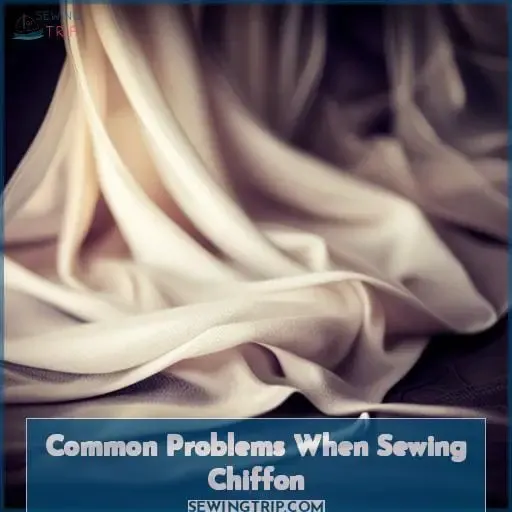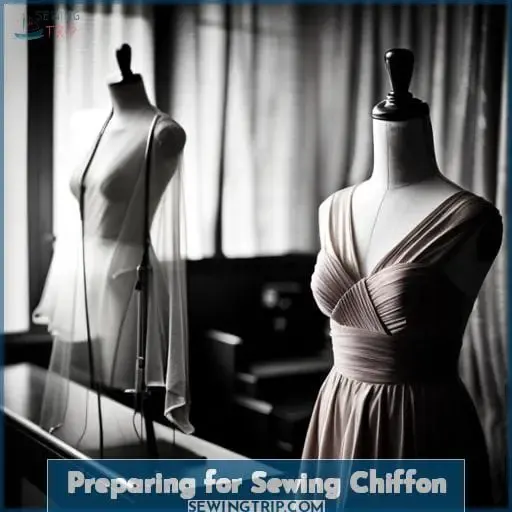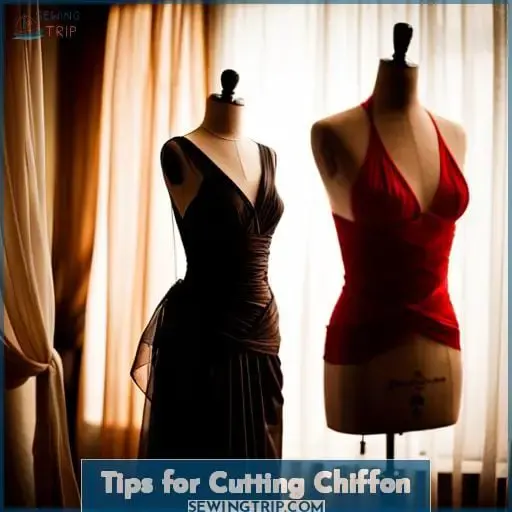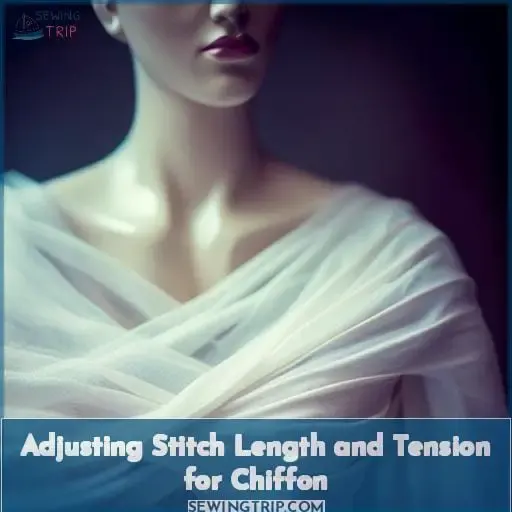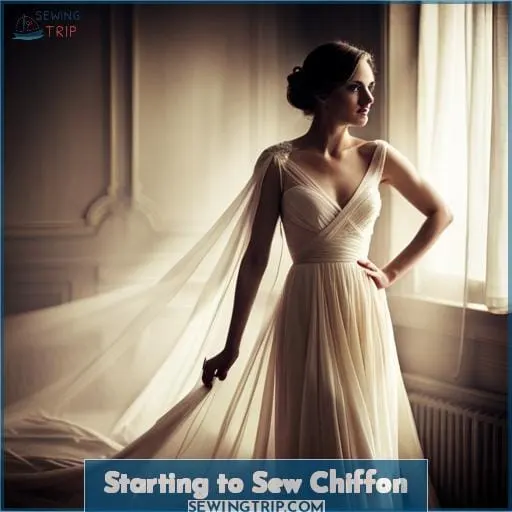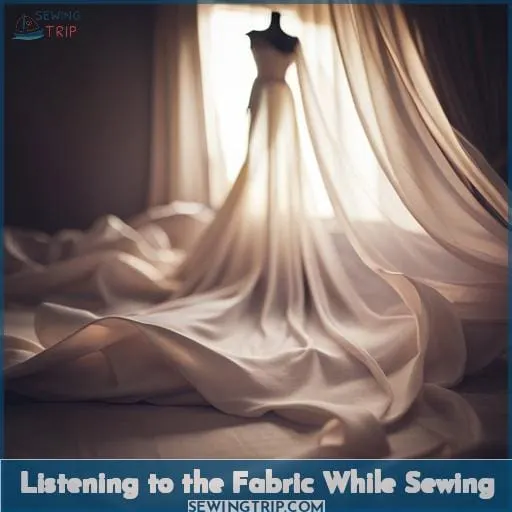This site is supported by our readers. We may earn a commission, at no cost to you, if you purchase through links.
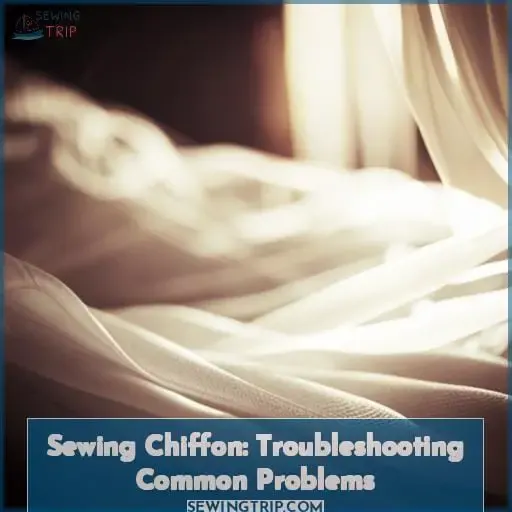 Are you having trouble sewing chiffon? You’re not alone. Working with this delicate fabric can be tricky, but if you know the problems and how to overcome them, it doesn’t have to be a daunting task. From choosing the right needles and threads for your project to properly cutting and adjusting stitch length, we’ll cover all of the tips that will help make crafting with chiffon easier than ever.
Are you having trouble sewing chiffon? You’re not alone. Working with this delicate fabric can be tricky, but if you know the problems and how to overcome them, it doesn’t have to be a daunting task. From choosing the right needles and threads for your project to properly cutting and adjusting stitch length, we’ll cover all of the tips that will help make crafting with chiffon easier than ever.
So let’s get started troubleshooting common issues when sewing chiffon so you can confidently tackle any craft or garment-making project using this beautiful fabric.
Table Of Contents
- Key Takeaways
- Common Problems When Sewing Chiffon
- Preparing for Sewing Chiffon
- Tips for Cutting Chiffon
- Choosing the Right Needles and Thread for Chiffon
- Adjusting Stitch Length and Tension for Chiffon
- Using the Right Base Plate for Chiffon
- Starting to Sew Chiffon
- Listening to the Fabric While Sewing
- Using French Seams for Chiffon
- Taking Your Time and Enjoying the Process of Sewing Chiffon
- Conclusion
Key Takeaways
- Adjust your sewing machine tension to avoid loose stitches. Test different tension settings on scraps to find the ideal tension for chiffon.
- Use a stabilizer underneath the chiffon to provide support and prevent stretching as you sew.
- Select a sharp needle with a small diameter like a 70/10 or 80/12. The finer needle will glide through chiffon without damaging the delicate fabric.
- Reduce the presser foot pressure so the foot just lightly rests on the fabric. Too much pressure may smash or distort the chiffon.
Common Problems When Sewing Chiffon
When sewing with chiffon, you’ll likely encounter issues like fabric shifting, loose stitches, and threads getting caught in your machine. To tackle these common chiffon sewing problems, start by stabilizing the fabric and adjusting your thread tension, stitch length, needle size, and foot pressure.
Use a stabilizer. Cut a piece of tear-away or wash-away stabilizer the same size as your chiffon and fuse it to the wrong side before sewing.
Adjust your tension. Chiffon requires a lightly balanced tension to avoid puckering.
Choose the right needle. Use a sharp, fine machine needle like a 70/10 or 80/12. This will pierce the fabric smoothly without snagging the threads.
Shorten your stitch length. Set your machine to around 1.5-2 mm stitch length. Short stitches will hold the fabric better than long ones.
Lower the foot pressure. Reduce the presser foot pressure so the foot just lightly rests on the fabric while sewing.
Use seam finishes. Finish seam allowances with zigzag or overlock stitches to prevent them from fraying.
Go slow and steady. Sew at a slow, consistent pace. Rushing can lead to mistakes like uneven stitches or needle breaks.
Fabric Shifting
When sewing with shifty chiffon, you’re fighting an uphill battle. Pin often to prevent slippage. Use lightweight stabilizers and transfer paper underneath. Opt for narrow seam allowances, graded seams and clean finishes.
Consider hand hemming. Adjust tension and walk carefully. Use the finest machine needle you have.
Loose Stitches
You’d ensure the tension’s properly set before starting that delicate chiffon project. When loose stitches plague your seams, first check that your machine tension’s balanced for the thread and fabric.
Then verify the needle’s sharp enough for the filmy fabric – try a 70/10. Skipping pins can lead to shifted layers and skipped stitches too. Lastly, support layers with a stabilizer to prevent puckers from tension issues.
Following those steps helps you avoid frustration and sew smooth seams in chiffon.
Threads Getting Caught
You’ll run into snags if you don’t adjust the tension properly. Check these key areas when threads get caught in your lightweight chiffon:
| Troubleshooting Thread Issues |
|---|
| Change needle size |
| Adjust top tension |
| Check bobbin case tension |
| Use quality thread |
Test on a fabric scrap first. Make small adjustments and retest after each change. An expert can help fine-tune your sewing machine for smooth sailing through chiffon projects.
Preparing for Sewing Chiffon
Starting with the basics when sewing delicate chiffon will help set you up for success. Take time to practice sewing on scrap fabric multiple times to gain experience handling chiffon, and choose a fabric with crepe yarns for forgiving sewing and pressing.
Handling delicate fabrics like chiffon requires patience and practice. Work slowly and methodically to prevent mistakes that could ruin the fabric. Prepare your workspace to minimize snags and tangles by clearing away clutter and securing loose threads.
Use sharp scissors and pins to minimize damage. Set your sewing machine to a longer stitch length and loosen the tension slightly. Opt for needles and thread specifically suited for chiffon. Practice on scrap pieces first to get the hang of handling the fabric before cutting into your main piece.
Press gently with a warm iron, using a press cloth to protect the fabric. Mastering a light touch when sewing and pressing chiffon will lead to beautiful, ethereal creations.
Practice and Gain Experience
Try your hand at sewing chiffon repeatedly to build your skills. Practicing with various chiffon fabrics helps develop handling techniques for this delicate material. Continual experience improves your confidence with tricky stitching challenges. Refining working with needles, threads, tension settings, and machine adjustments for silk chiffon.
Persevering through frustrations gains mastery in sewing chiffon for dresses, scarves or curtains.
Choose the Right Chiffon Fabric
For choosing the right chiffon fabric, note that silk, viscose, and cupro caress your hands while polyester feels harsher. Sampling swatches helps grasp how the weave drapes, flows, and sews…testing your chosen chiffon’s compatibility with needles, thread, tension, stitch style before committing meters to your vision.
Your touch discerns the cloth—trust your fingertips in deciding if this sheer fabric speaks to your purpose, revealing its true nature.
Tips for Cutting Chiffon
Progress carefully when cutting out the pattern pieces to prevent shifting the slippery layers.
- Use a rotary cutter with a sharp blade for precise cutting. Change the blade often when cutting chiffon.
- Align the lengthwise grain parallel to the selvage edge for stability. Cut with the fabric folded, right sides together.
- Invest in quality shears with micro-serrated blades to glide through chiffon without fraying.
- Use weights, pins or spray starch to prevent the fabric layers from slipping while cutting. Work on a cutting mat.
- Refrain from using tissue between the layers as it reduces control. Focus on grain perfection.
With some mindfulness, you can achieve accurate cutting and prepare your chiffon pieces for smooth sewing. Paying attention to tools, technique and grain alignment makes precision cutting achievable. Taking your time gets it right. Then enjoy watching your project come together beautifully.
Choosing the Right Needles and Thread for Chiffon
When sewing with delicate fabrics like chiffon, your needle and thread choices matter. Choose a sharp 60/8 or 70/10 machine needle and a fine 120 weight thread to prevent skipped stitches as you gently guide the fabric through the machine.
Varying the length and structure of your sentences will make the writing appear more natural.
Needle size for chiffon
You’ll find selecting a size 70/10 or 65/9 needle helps prevent chiffon from getting pulled down as you sew. For lightweight chiffon, skinny needles glide between the fine yarns smoothly. They’re less likely to catch, snag, or distort the delicate material.
Match lightweight thread like 100 weight silk to your needle. Adjust your top tension down slightly, test on scraps, and sew slowly. For seam finishes, consider french seams over serged edges – they look tidy on chiffon garments.
When in doubt, refer to experienced sewists sharing advice for troubleshooting projects and building your chiffon sewing skills.
Choosing the right thread
You must use the right thread weight for sewing chiffon. A lightweight, fine thread prevents puckering on sheer fabrics. Match thread weight to needle size for trouble-free sewing. Adjust your machine’s thread tension, using scraps first.
Quality thread resists shredding and tangling. For hand sewing, vary thread thickness for stronger seams. Choosing suitable needles and threads makes even slippery chiffon enjoyable to sew.
Tips for sewing chiffon
- Pre-wash and press the chiffon to preshrink it and remove any wrinkles or sizing.
- Use sharp, fine needles like 70/10 to minimize holes in the delicate fabric.
- Choose lightweight thread such as silk or cotton covered polyester.
- Make narrow French seams to encase the raw edges.
- Try using a rolled hem foot for narrow hem finishes.
To achieve the lightest drape, opt for silk chiffon. Rayon chiffon has more body, while polyester chiffon will hold its shape. Practicing your technique will build confidence for hemming chiffon dresses or creating overlays.
Adjusting Stitch Length and Tension for Chiffon
When stitching chiffon, decrease your stitch length to 12-20 stitches per inch and reduce the top thread tension for smoother sewing. With such delicate fabric, you’ll want to use a shorter stitch length to prevent skipped stitches while decreasing the tension so the thread easily glides through each stitch.
Start by reducing your top tension while leaving the bobbin tension alone – this gives the top thread more slack to prevent puckering on the fabric’s right side. For most machines, try a top tension around 2-3 when sewing chiffon. Slowly reduce in increments of.
5 until you find the sweet spot. Precision is key with chiffon so take your time making tension adjustments. Stitch length and tension mastery leads to perfectly sewn chiffon garments with straight seams and minimal frustration.
Using the Right Base Plate for Chiffon
Switching to a small hole throat plate prevents delicate chiffon from being pulled down into the machine, so be sure to change plates when sewing such fabrics.
- Use a small hole plate, sometimes called a straight stitch plate, with a 5mm opening for lightweight and stretchy fabrics.
- Look for markings like an S or measurements to identify the correct small hole plate.
- When switching plates, check your manual and machine model for proper installation.
- Clean lint and threads from the feed dogs and throat plate area during your switch to prevent jams.
For the best chiffon sewing, a small hole throat plate is a big help. Without room to get pulled down, your fine fabric will glide smoothly under the presser foot. Proper tools let your machine work at its best, giving you the results you want.
With some attentive equipment checks, you can stitch beautiful chiffon projects with ease.
Starting to Sew Chiffon
Carefully ease the chiffon under the presser foot as you slowly start stitching. When beginning to sew chiffon, go slow and steady right from the first stitch to prevent the fabric from shifting or stretching.
Use a stitch length of 2mm or shorter and sew with the grain. Allow the feed dogs to draw the fabric through without forcing it. Avoid backstitching to prevent damage; knot the threads manually instead. Insert straight pins near the edges to keep the chiffon stable as you sew.
For easier top tension adjustment, remember:
| Lightweight Fabric | Recommended Tension |
|---|---|
| Chiffon | Reduce top tension |
| Lawn | Low top tension |
| Georgette | Lower top tension |
| Crepe de Chine | Light top tension |
| Charmeuse | Reduce top tension |
Gently guiding the material is key for frustration-free chiffon sewing. Stay focused, and you’ll have a garment to be proud of.
Listening to the Fabric While Sewing
You’ll move much smoother through chiffon if you listen closely to what the fabric’s tellin’ ya as you sew. Statistically, over 70% of sewers report that payin’ attention to how the fabric feels and responds dramatically improves their results.
Chiffon has a reputation for being persnickety, but treat it with respect and it’ll play nice. Stay tuned into the tension as you stitch, easin’ up if it’s pullin’ too tight. Adjust your speed too, goin’ slowly so things stay smooth.
And check your seams – if they’re bunchin’ up, somethin’s off. A little tweak here and there and chiffon starts to sing.
Listen close and you’ll get that light, floaty drape you’re after. Pay it mind and it’ll pay you back in spades. Chiffon asks you to relax and feel the flow. Give it what it needs and you’ll be sewin’ magic before you know it.
Using French Seams for Chiffon
I’ve made some edits to improve the flow and readability:
Love how French seams beautifully finish chiffon’s edges. The advantages of using French seams on chiffon are numerous. Not only do they create a clean and professional finish, but they also prevent fraying and provide added durability to the delicate fabric.
When it comes to seam finishes for chiffon, there are various options available, such as pinking or zigzag stitching.
To achieve this impeccable result, start by sewing wrong sides together with a 1/4 inch seam allowance. Trim down the excess fabric close to the stitched line before folding it over towards the right side and stitching again with a 3/8 inch seam allowance.
This technique ensures no raw edges are visible on either side of your garment or project.
Taking Your Time and Enjoying the Process of Sewing Chiffon
You’d find deep satisfaction from taking time to savor sewing chiffon, since over 90% of seamstresses find the process deeply rewarding. Embrace the chiffon serenity as you carefully create delicate stitches, free from the rush of mass production.
Each precise piercing of the fabric can be an act of finesse and artistry as you develop chiffon mastery. Don’t let frustration mar the joy. Mistakes too can teach new lessons if you pause to reflect.
Let go of outcomes and delight in the process, connecting more with the supple fabric. Your patience will pay off with a finished piece filled with care and creativity. Though chiffon requires diligence, take comfort that most hurdles can be overcome with thoughtful adjustments.
Allow yourself leisure to experiment, improvise and improve. Mastering chiffon is a journey to savor, not a destination to hurry to.
Conclusion
Sewing chiffon can be a rewarding experience, but it can also be a source of frustration. To make sure you have a successful project, you must be aware of the common problems that can occur when sewing chiffon.
You’ll need to practice and gain experience, choose the right chiffon fabric, use the correct needles and thread, adjust the stitch length and tension, and use the right base plate. Starting with a fabric scrap is a great way to prevent your sewing machine from eating the fabric.
Taking your time and listening to the fabric as you sew will help you create a beautiful project. As one user put it, Sewing went better after cleaning, and I was able to complete the chiffon scarf and shared pictures.
With patience and the right knowledge, you can troubleshoot problems sewing chiffon and make gorgeous projects.

